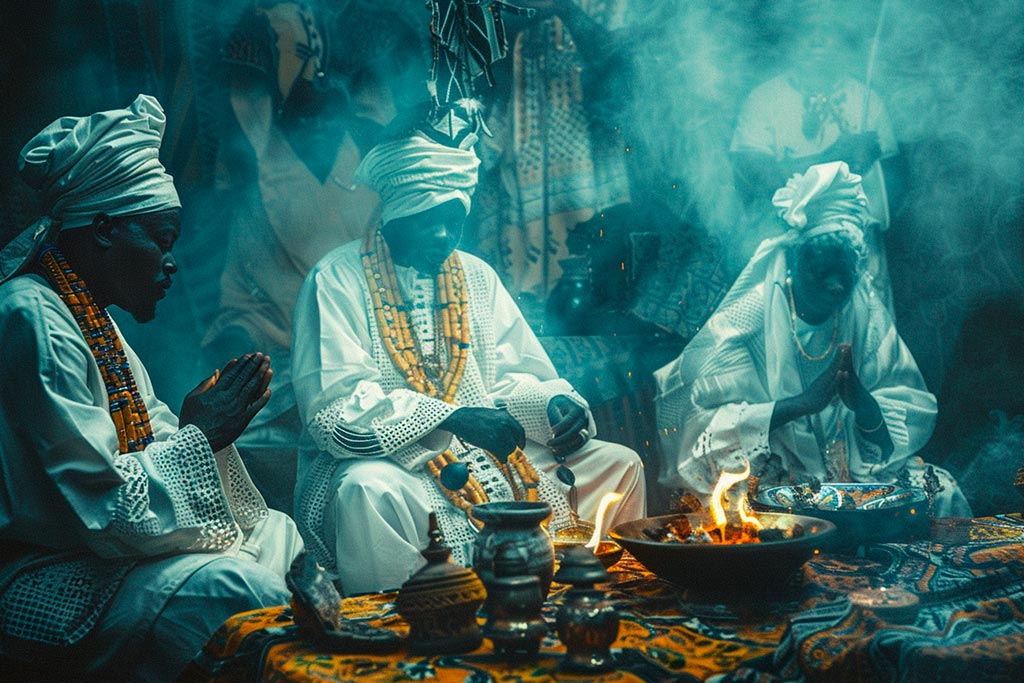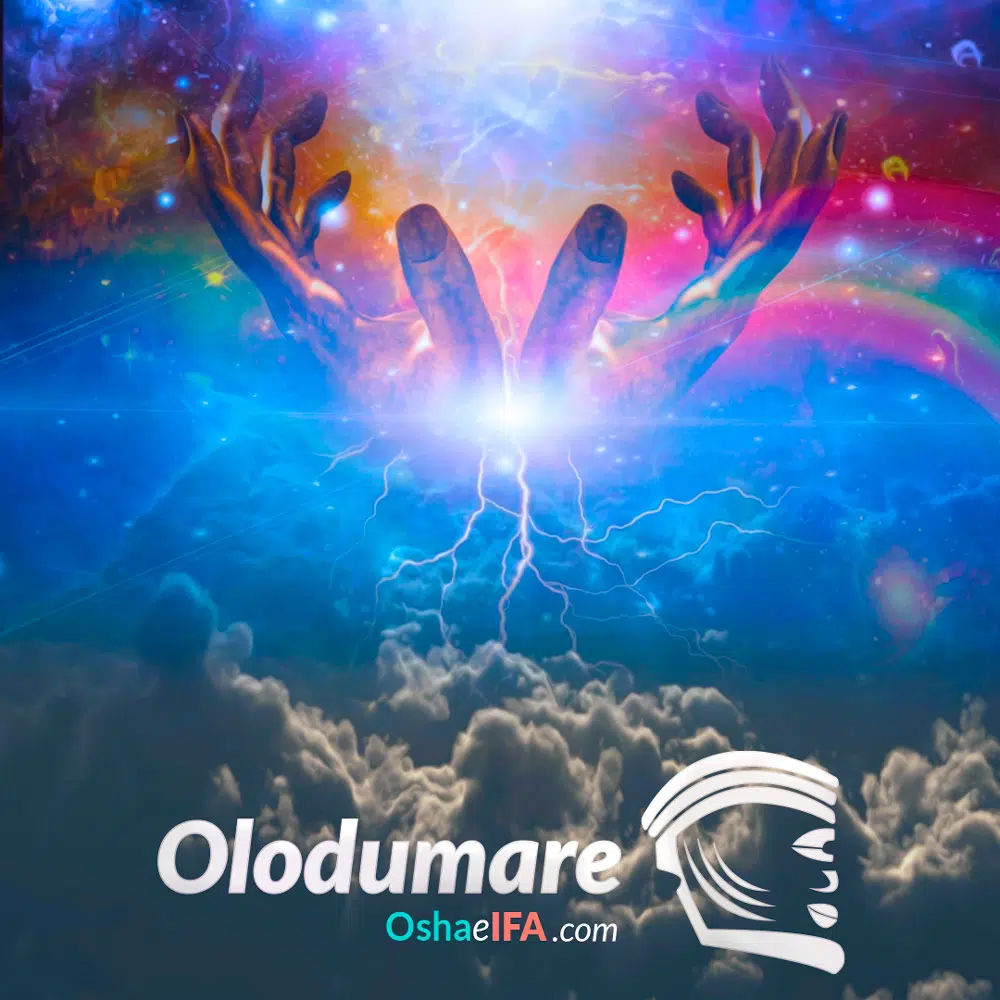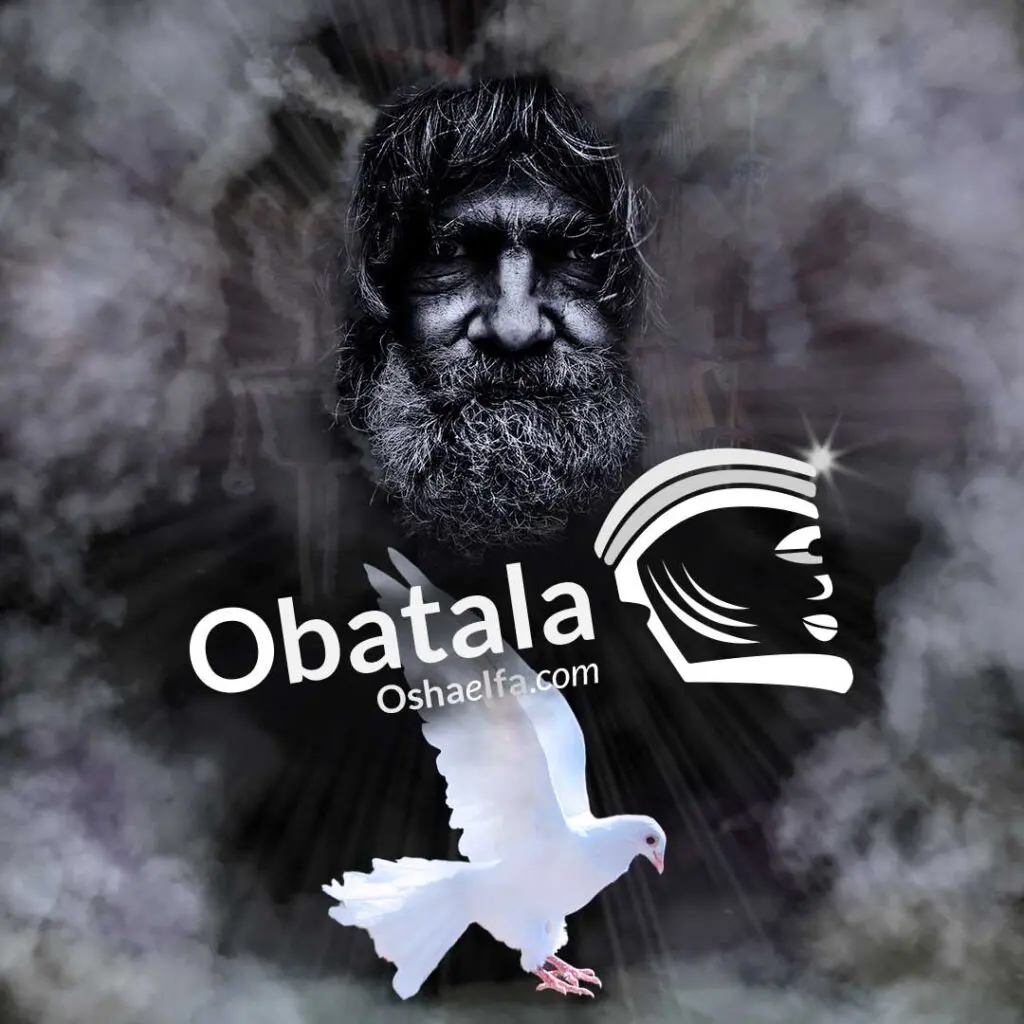What is Santeria?

Santeria is a term used to refer to Afro-Cuban practices corresponding to the rule of Osha. It is a polytheistic religion with African roots belonging to various Yoruba tribes (including the ethnic groups of: Egba, Ketu, Ijebu and Ife), located in what is currently known as Nigeria, Togo and the Republic of Benin. It is managed under quite complex philosophical and ethical concepts, because, over time, customs from other religions and ethnicities have been indexed.
Yoruba religious practices arrived in America during the time of slavery, settling mainly in Cuba, being the cultural and religious epicenter from where it expanded throughout Latin America.
"In the early 17th century, the Ewe people invaded the region of Dahomey and neighboring kingdoms, forcing Yoruba tribes to migrate to the Nigerian coast, where many of them were captured by slave traders and brought to the New World." .
Migene González. Santeria African magic in Latin America. (1973, p. 11)
In other countries such as Brazil and Haiti, African culture also spread during times of slavery. Not only did slaves who believed in the Orishas, but also other cultures, arrive in these areas. Forced to live together, transculturalization was generated that affected their religious bases, generating a fusion of beliefs, ceremonies and cultural traditions.
The most popular variant is the one that mixes the beliefs between followers of Osha and followers of Ifism, "relatively" fusing the two religions, to form what we know today as: "rule of Osha and Ifa." Under this rule priests from both cultures converge. Their practice was also called "lucumi." In this regard, Migene González (1973) states that:
"In Cuba, where Santeria developed extensively, the Yorubas were known as lucumíes, a term derived from the Yoruba word akumí, which is the name given to a native of Aku, a region of Nigeria from which many Yorubas came." (p. 13).
The belief of Osha and Ifa is based on the relationship between the earthly plane and the spiritual plane. Considering sacrifice (ebo) as the solution or liberation from problems, since the fundamental basis of religion is that life is nothing other than giving to receive. He who sacrifices will be absolved. The offering is liberation (odu of Ifa Oyekun Meji).
The sacrifices made to the different Orishas are made up of: animals, plants, and various offerings, with the purpose of receiving some benefit (ire) or warding off any adversity. In this sense, Ócha'ni Lele (2012) points out that:
«Therefore, the act of sacrifice is one in which the profane becomes sacred and divine. In the Lucumí faith, sacrifice is not always about the offering of animals; Everything we do as aborishas, non-consecrated worshipers of the Orishas, or as olorishas, priestesses and consecrated priests, is considered an act of sacrifice. Even our daily words and actions are sacrifices, offerings. (p.37).
A determining factor in the origin of "Santería" in Cuba was syncretism, that is, "the spontaneous, popular combination or reconciliation of different religious beliefs" (González Migene. 1989, p 13). This phenomenon occurs as a result of the Catholic influence of the Spanish who subjected the Africans brought to America to slavery during colonization.
Faced with adverse conditions and the limitation of their freedoms, the Yorubas identified their gods with the saints of Catholic doctrine, giving way to the so-called Santería, a term that is derived from the worship of saints, and which, in turn, originates that the Orishas are commonly called that way.
To understand the foundation of the Yoruba religion It is necessary to study its cosmology. Initially, it is believed that Olodumare (God) created himself, being the first cause. This is the reason why, he is called: the only wise man on Earth. It is the only cause in Creation (odu of Ifa Osa Kuleya).
The Yorubas believe in Olodumare as an omnipotent God, responsible for the creation of most things in the universe, including the different deities (Orishas), to whom he delegated many functions, such as: completing some aspects in the creation of the world. and the earthly plane.
Olodumare remains relatively distant from human beings, which is why he commissioned the Orishas, also known as Oshas, to attend to his needs. In an interpretive way we can see the Orishas as mediators between human beings and God. R. P Baudin (1884), in his book Fetishism and fetishism, Maintains that:
«Black people do not have statues or symbols to represent God. They consider him the primordial Supreme Being, author and Father of the gods and spirits. At the same time they think that God, after beginning the organization of the world, commissioned Orichanlá to finish it and govern it, then retiring to eternal rest..."
This does not mean that Olodumare is oblivious and indifferent to the situations that arise, therefore, when a person worships his guardian angel (Orisha Alagbatorí) he would be worshiping Olodumare and thus the function of mediator between humans and the almighty God.
It is said that Olodumare created man with the purpose of serving his divinities and thus improving spiritual development, since the Yoruba belief indicates that life on Earth is ephemeral and fleeting. Stating that, it is man who needs Olodumare to live and prosper.
Something essential in Yoruba beliefs, and of course, in the rule of Osha and Ifa is the making of sacred objects, fundamentals, or attributes that serve for worship, tools for divination with different oracles and different religious practices, directly related to deities and the powers of nature.
Through these foundations, it is possible to establish a more direct connection with the Orishas for the benefit of the initiate. Coming to believe that, through religious rites, the energy of an Orisha is consecrated or deposited in one or several stones (Ota or Okuta), which have previously been asked if the spirit or deity we are looking for lives in it. and, likewise, if it is compatible with the person to whom the ceremony will be performed. Likewise, it is believed in the importance of the spirit that lives in plants (ewe) and animals, through which the religious foundations created by man are given life.
This gives rise to the central question of the cult who are the Orishas? The Orishas are the deities that Olodumare created, whose purpose is to complete different tasks, for which he gave them different powers. Among them, finishing the process of creating the world, as well as that of the human being. Additionally, as stated above, they act as the link between heaven and Earth.
«the word Òrisá, as we have defined, results from the contraction of ‹eni ti o-ri sa ninu ogbon Òlòdùmaré› that level of consciousness that achieved greater knowledge of Òlòdùmaré... each Òrisá is in itself, an elongation of the raw energy of Òlòdùmaré, they are at the same time, the different emanations of Òlòdùmaré, which carry out the execution in an orderly manner and with a purpose given by Òrùnmílá».
Ifa Orilana Aworeni Odumola Sowunmi. The nature of the Orisas. (2009, p. 62).
Their story tells that when the Orishas (Oosa) were created by Olodumare (God), they were given the name Irunmole. They manifest themselves in two ways. On the one hand, they came to Earth in human form, to fulfill missions given by Olodumare, and to serve as an example of good customs, work and faith in the different societies in the Yoruba environment. It was this earthly stage that allowed him to ascend to the status of Orisha (a process of transcendence that can be compared to beatification).
On the other hand, each of them also inhabits the energies of human emotions and actions, as is the case of Oshun whose power of social action is associated with love; Ochosi, who represents justice within the collective consciousness; and Ogun who is an active agent in war, to name a few examples.
Through the sacred texts of Ifa in the Yoruba tradition, it is established that there are two pantheons of spiritual powers that act on the universe, made up of: four hundred right-wing deities, known as Orishas, whose action is benevolent; and two hundred spiritualities of the left, identified as "ajogun", which are malevolent.
In the middle of them, there is Eshu, one of the most powerful deities within the Yoruba religion, who acts as an impartial judge and messenger, capable of mediating between both groups and, in addition, uses the sacrifices offered by humans to prevent be harmed by the deities of the left.
Among the most popular Orishas are: Elegua (messenger deity and owner of the roads); Ogun (god of iron and metals); Oshosi (spirit of hunting and justice); Obatala (owner of all heads and purity); Oya (goddess of wind and sparks); Oshun (deity of wealth and sweet waters); Yemaya (goddess of the sea and motherhood); Shango (god of fire and lightning); and Orunmila (owner of wisdom and fortune teller of the Ifa oracle).
All Orishas have their own personality that is manifested in the different myths or stories, called "patakies" (verses from the Ifa corpus and dilogun). Both the personality and the experience of the different deities serve as an example of conduct, and set us the sacrifices (ebo), or restrictions (taboos), with which we can improve our lives on the earthly and spiritual plane. Take as an example a story from the odu Okana Yabile (Ojuani) that tells:
«He made divination for Shango when he came to Earth, warning him that he must make sacrifice. All the divinities agreed that Shango was very aggressive and volatile, and that, especially, he was always breathing fire when he spoke. When the other divinities finally banished him, he went to Orunmila for divination. He was warned that he must make sacrifice with a ram and the other paraphernalia. He made the sacrifice, after which the other divinities invited him for rapprochement and fellowship. He declined the invitation and everyone went to his house quickly in search of reconciliation.
As we see in the previous text, in the face of a pressing situation, the Orisha Shango He found it necessary to go before the Ifa oracle, who told him the advice and sacrifices he should make to solve his problem. This also shows that each deity has characteristics that define its personality.
These types of behavioral traits are widely studied by the practitioners of this religion, because each Orisha has the mission of protecting and helping certain people incarnated on the physical plane, being identified as their guardian angel, Orisa Alagbator, or father and mother, respectively.
«If an individual chooses Santería as their religion, one of the first things they do is find out who their personal Orisha is. This is done through one of the divination systems used in religion. From the moment he learns the name of the Orisha from him, the practitioner constantly and assiduously asks that deity for help and guidance throughout his life. He considers himself his son, and if he ever decides to “play the saint,” he can only be initiated into the mysteries of that Orisha.
Migene González. Santeria religion. (1989, p. 12).
In the case of Shango, he is a saint who is identified as a symbol of violence and anger, sometimes disproportionate. Therefore, it has been wrongly interpreted that the influence they have on their children makes them act in a fickle and irrational way when, on the contrary, it is a behavior that must be controlled, developing, rather, the search for conciliation before the problems like Shango did in the story of the odu Okana Yabile.
In this same way, moderation and Good character (iwa pele) is a behavior that all practitioners of the Yoruba religion must work on, regardless of who your guardian angel is and their individual characteristics, in order to avoid negative behaviors, justifying and misinterpreting the teachings left in these stories.
Another Orisha of great relevance within Yoruba beliefs is "Ori", translated as: head. But, this spirituality refers to something deeper than the physical head as such, it is about individual consciousness, granted to each human being by Olodumare. He is the spiritual being, bestowed and linked to the Supreme God. This energy that individualizes us is what keeps the knowledge of past lives and guides us in this one to fulfill the destiny we have chosen in heaven, before settling in this earthly body (ara). Diane Caudillo, (2007), in her book Prayers to the Orishas a look at Santería, states that orí is:
«the principle of predetermined destiny and the spiritual aspect of human beings. Orí is also considered one of the Orishas... Before birth, humans select for themselves their ‹Orí› (the internal or spiritual head), which will determine whether they will have good fortune. (p. 4).
During Orí's journey on Earth (the incarnation), the Orishas of the Yoruba pantheon, as guardian angels, accompany us, providing us with their support and protection to fulfill the destiny determined for each of us, offering their advice and works. recommended through divination and conversations corresponding to the rituals or consecrations to which we undergo during our lives.
What does it mean to be a santero?
The word "santero" is usually commonly used to refer to followers of the practices inherited from the Afro-Cuban Yoruba religion. However, it was originally a pejorative term with which "white masters" referred to the adoration that slaves had towards Catholic saints, after the religious imposition to which they were subjected. Despite this, this devotion hid behind it the worship of its original deities, fused or camouflaged through syncretism.
Many decades later, at the beginning of the 20th century, Yoruba freedmen such as Timotea Albear "Latuan", Ña Rosalía Abreu "Efunshe Warikondo", Ma Monserrate González "Obatero", Fermina Gómez "Osha bi", Octavio Samá "Oba di melli", Aurora Lamar «Oba Tolá», Ña Belén González «Apoto», and Ño Remigio Herrera «Adeshina – Obara meyi», among others, began to organize and largely rescue their traditions, adapting them to the conditions of the time and the context, giving origin to what is known today as the rule of Osha and Ifa.
But, although certain conditions had changed, the Olorisha, Iyaloshas and Babalosha (consecrated through the Kariosha ceremonies to their tutelary Orisha) continued to be called santeros, which is sometimes a cause of controversy, because Many initiates consider it to be a derogatory term given its origin, although it remains the most popular adjective by which the rule of Osha and Ifa (Santería) and its consecrated persons (Santeros) are known.
In any case, the priesthood for the Olorishas or Babalawos (consecrated in Ifism), beyond a simple belief or religion, is a way of life, which is based on the traditions and knowledge inherited from the ancestors, always close, intimate and active in his relationship with the Orishas, who are fundamental in his daily life.
Therefore, their worship is not impersonal, the followers and initiates pray, speak, attend, love and cry out for help to their deities face to face, either through their foundations, in the place they occupy in nature, or when they speak through their children in trance. In that sense, nothing is more timely than the words of González Migene (1989), when he maintains that:
«There is something very moving and strangely comforting about talking face to face with an Orisha. He reminds us that somehow God is near, that he cares about us, that we are not alone. "It is this strong interaction with the Orishas that makes Santería such a powerful and dynamic religion, and explains its growing popularity." (p.14).
Conclusion:
Santeria, with its deep roots in African Yoruba culture, emerges as a complex and multifaceted belief system that transcends the simple label of religion to become a way of life intrinsically intertwined with the daily existence of its followers. This practice, brought to the Americas by African slaves and shaped under the yoke of colonization, not only survived oppression but flourished, adapting and evolving to absorb elements of other religious traditions in an impressive act of cultural and spiritual resistance.
Syncretism, a fundamental pillar of Santeria, not only reflects this faith's ability to harmonize disparate beliefs but also highlights its inclusive nature, capable of providing refuge and solace to those marginalized by more dominant belief systems. Through the veneration of the Orishas, entities that personify the forces of nature as well as aspects of the human condition, Santeria practitioners embark on a journey of deep spiritual connection, guided by ancestral wisdom and the principles of reciprocity. , sacrifice and community.
This religion, at its core, is a celebration of life, a recognition of the interconnection between the divine and the earthly, where every act of worship, every sacrifice and prayer, not only seeks divine intervention in worldly affairs but also affirms the intrinsic value of each individual in the vast tapestry of existence. As Santeria continues to expand beyond its origins in Yorubaland and Cuba, its ability to adapt, its deep respect for nature, and its commitment to justice and equity position it as an increasingly relevant source of spirituality and community. in our globalized world.
In conclusion, Santeria represents a vibrant testimony of the resistance and resilience of the human spirit in the face of adversity. Her story is a reminder that even in the most difficult circumstances, faith and community can flourish, offering light and guidance to those seeking a path to harmony, well-being, and deep understanding of the mysteries of life.
References
- Caudillo, Diane Elizabeth. (2007). Prayers to the Orishas to look at Santería.
- De Sousa Hernandez, Adrian. (2005). The Orishas in Africa. An approach to our identity. Editorial of Social Sciences.
- González-Wippler Migene. (1973). Santeria African magic in Latin America. Llewellyn Publishing.
- González-Wippler Migene. (1989). Santeria religion. Harmony Books.
- Ifa Orilana Aworeni Odumola Sowunmi. (2009). The nature of the Orisas. Rosebud Editions.
- Morgaine Raven. (2021). Orisha, Goddess, and Queen of the Sea. Weiser Books.
- Ócha'ni Lele. (2012). Sacrificial Ceremonies of Santería: A Complete Guide to the Rituals and Practices. Destiny Books Publisher.
- RP Baudin. (1884). Fétichisme et féticheurs. Seminaire des missions africaines: Bureaux des missions catholiques.



